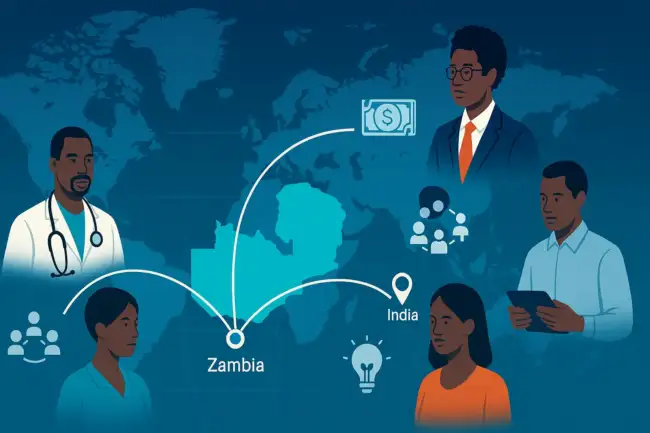Introduction
Migration is one of the most significant demographic and socio-economic forces shaping modern societies. As individuals move within and across borders, they influence labour markets, education systems, urban planning, healthcare provision, and national identity. In Zambia, like many countries, migration holds vast developmental potential. However, this potential remains largely untapped due to a critical missing piece: accurate, timely, and comprehensive migration data.
Without reliable migration data, Zambia struggles to craft effective policies, allocate resources efficiently, and engage with its diaspora meaningfully. This article explores the hidden costs of poor migration data on Zambia’s development, highlighting internal migration, irregular migration, and emigration as critical areas of concern. It also proposes actionable recommendations to bridge these data gaps and steer the nation towards a more informed and inclusive development trajectory.
Understanding Migration’s Developmental Role
Migration, when well-managed, contributes significantly to development. Benefits include labour and skills exchange, increased remittances, foreign direct investment, technological transfer, and cultural enrichment. Migrants, especially those in the diaspora, play a vital role in building bridges between their countries of origin and host nations. For Zambia, which aims to become a prosperous middle-income country by 2030 under Vision 2030, leveraging migration effectively could help unlock economic diversification and national resilience.
However, achieving this vision requires solid evidence. Reliable migration data helps policymakers identify trends, predict needs, and design targeted interventions. Unfortunately, Zambia’s migration data landscape is fragmented, outdated, and insufficient.
The Current State of Migration Data in Zambia
Zambia primarily relies on national censuses, household surveys, and administrative records to collect migration data. The census is conducted once every ten years, meaning it cannot track real-time trends or short-term movements. Household surveys are often underfunded, irregular, and geographically limited. Administrative data, though potentially useful, is not systematically collected or harmonized across institutions.
As a result, Zambia lacks consistent data on internal migration patterns, irregular border crossings, return migration, labour flows, and diaspora engagement. Many government institutions operate in silos, collecting overlapping or contradictory data with no central coordination mechanism. In 2019, the country made progress by publishing its first-ever Migration Profile, but even this relied heavily on outdated or international data sources.
The Cost of Inaction: Developmental Setbacks
- Urbanisation and Infrastructure Strain
Poor internal migration data hampers Zambia’s ability to plan for urban expansion. Without understanding the volume and drivers of rural-to-urban migration, cities become overwhelmed by informal settlements, inadequate sanitation, traffic congestion, and crime. Rural areas, meanwhile, face depopulation, especially of youth, undermining agricultural productivity and rural development. - Weak Irregular Migration Control
Inadequate data on irregular migration makes it difficult to combat human trafficking, smuggling, and illegal labour markets. Zambia was downgraded to the Tier 2 Watch List in the U.S. State Department’s 2020 Trafficking in Persons Report, partly due to insufficient data on trafficking routes, victim profiles, and law enforcement effectiveness. - Unengaged Diaspora
The Zambian diaspora is a valuable source of remittances, skills, and international networks. However, the country lacks a centralized mechanism to track emigrants or understand their reasons for leaving. Very few Zambians register with missions abroad, and existing departure forms at borders are designed for foreign nationals. This results in lost opportunities for diaspora engagement and policy feedback. - Policy Blindness and Missed Opportunities
Policymaking without data is like flying blind. Zambia cannot effectively integrate migration into national development plans without understanding the movement of its people. From health and education to housing and security, all sectors are affected by migration—yet decisions are being made on assumptions rather than evidence.
Why a National Migration Policy Is Urgent
Zambia currently lacks a comprehensive national migration policy. This absence means there’s no central framework to coordinate the various government agencies involved in migration, nor a vision to align migration management with national development goals.
A national policy would:
- Clarify institutional roles
- Establish inter-agency coordination mechanisms
- Promote data-sharing standards
- Ensure the inclusion of migration in development planning
Critically, such a policy should adopt a “whole-of-government” and “whole-of-society” approach, recognizing that migration intersects with trade, agriculture, health, education, and justice.
Recommendations for Improving Migration Data Systems
- Establish a Centralized Migration Data System
Create an electronic platform that consolidates data from all relevant institutions—Immigration, Labour, Education, Health, and Foreign Affairs. This platform should track internal, inbound, outbound, and return migration flows. - Update National Statistical Tools
Integrate migration-specific questions into existing statistical instruments like the Living Conditions Monitoring Survey and Labour Force Survey. Develop a migration module within the next census. - Mandate Migration Reporting Across Agencies
Assign specific responsibilities to institutions for tracking emigration (e.g., Ministry of Foreign Affairs), internal migration (e.g., Ministry of Local Government), and returnees (e.g., Ministry of Community Development). - Capacity Building and Training
Train civil servants, statisticians, and data scientists on migration concepts and data management. Encourage a culture of evidence-based planning across all levels of government. - Regular Migration Profiles and Research Funding
Institutionalize the publication of a national migration profile every 3–5 years using updated data. Allocate specific government funding for migration-related research.
Conclusion
Zambia stands at a critical crossroads. The lack of reliable migration data is not just a technical oversight—it’s a developmental barrier. To realize the ambitious goals outlined in Vision 2030 and the 8th National Development Plan, the country must treat migration as a strategic pillar and invest in understanding its complexities.
A comprehensive migration data system, underpinned by a national migration policy, will not only improve governance but also unlock the full potential of Zambians—wherever they are in the world. The time to act is now. If Zambia fails to capture the movement of its people, it risks being left behind in a world where mobility defines progress.
Disclaimer: This article is for informational purposes only and does not constitute legal advice. The views expressed are those of the author and do not necessarily reflect the official position of YMS Legal.



